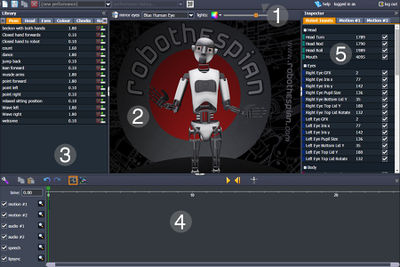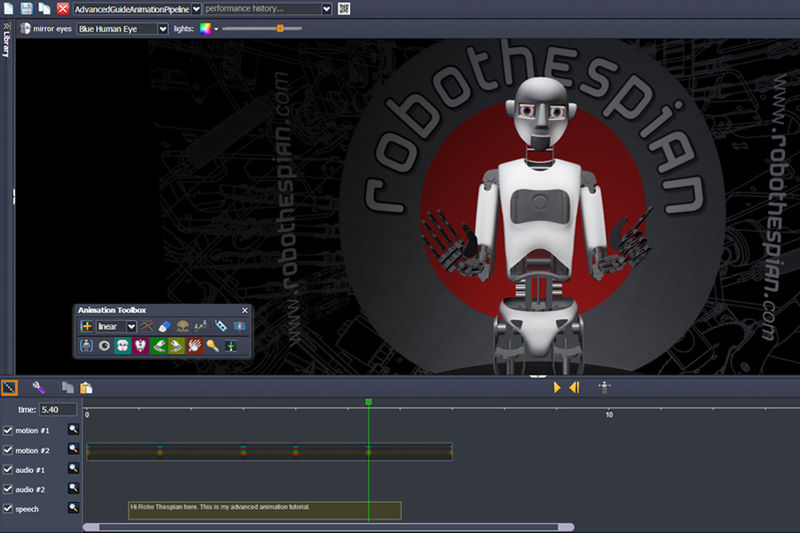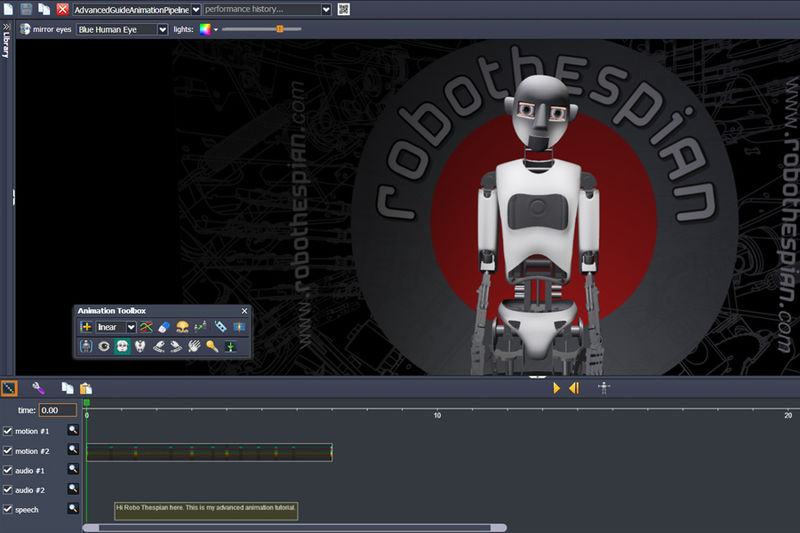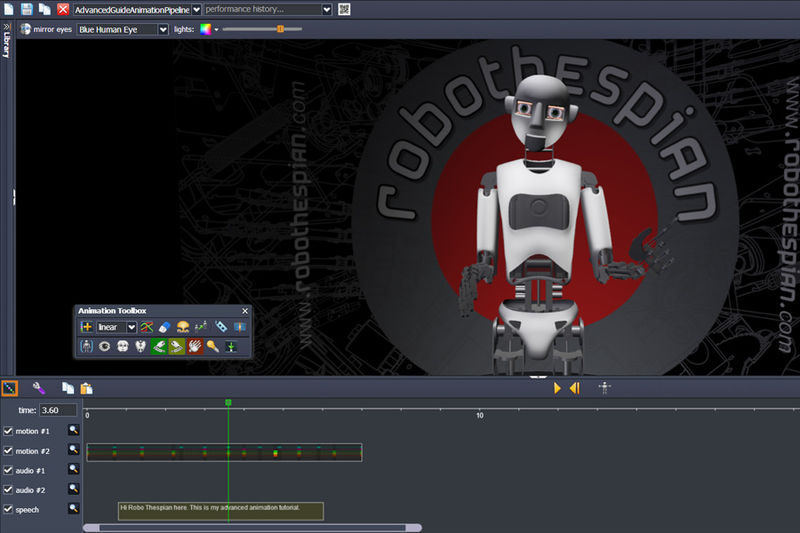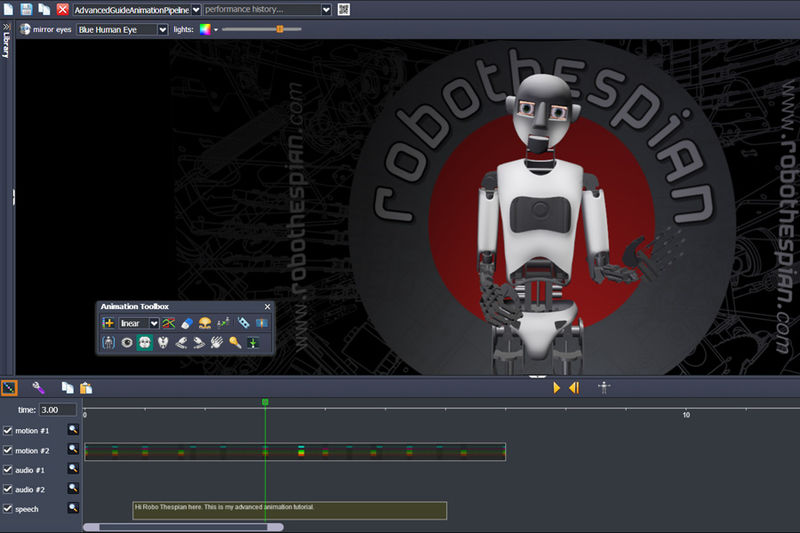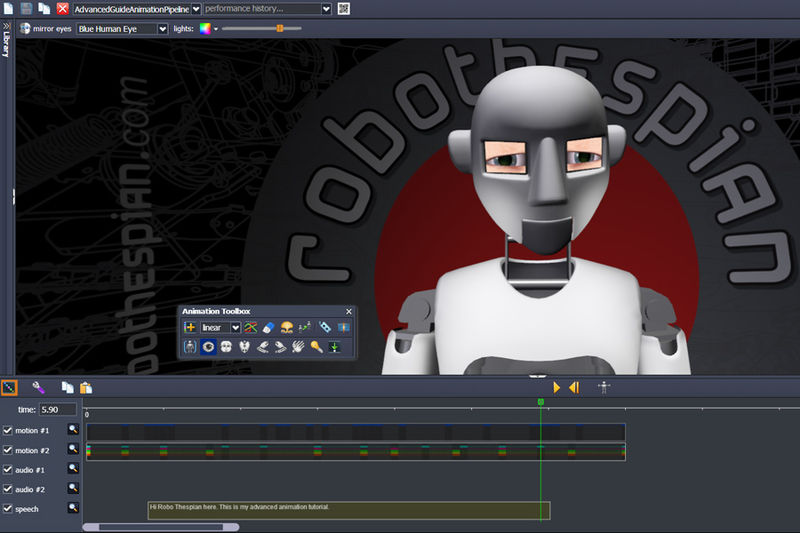Virtual Robot - Advanced Guide to the Animation Pipeline
Virtual Robot > Advanced Guide to the Animation Pipeline
Contents
Introduction
A good production process is essential if you are going to be creating large amounts of content using VR. Keeping your performances well organised using a consistent method of production is essential. You can animate in VR any way you like, but the following step by step guide is based on how we like to work. A methodical approach from beginning to end, building up layers of detail whilst saving incrementally.
Please refer to this page Animation Terms & Definitions for more detailed information about animation terms used in this guide.
Prepare to use VR
First things first, make sure you have read about the Virtual Robot Interface & Environment , so you become familiar with the user interface layout and the tools provided.
To create a performance you need a script. Once the script is finished, act it out. Work out which gestures work best for Robothespian to perform. Keeping in mind Robothespian has physical limitations, such as, raising his arms above the head, crossing the arms, pointing to itself, touching the chin etc. Considering the limitations and working around them, will help you develop a visual language for RT to use. As you become familiar with VR and how it translates movements to Robothespian, you will learn what kind of movements work and look best.
When you have a good routine planned out on paper, act it out. Then film it. You can use the video as reference for gesture timing and also blinking. Audio files can be dropped into the timeline. We recommend using the .ogg file format which uploads quickly and is fully supported by VR and RT. If you are using Text to Speech to generate a script, organise the clips in the timeline before you start.
Use Motion Tracks
For best results in terms of productivity, ease of editing and making late changes to files its best to organise a performance so all body part animation is done on one motion track. The eyes and lights are kept separate because they usually involve more detail and different timing to the body.
If the eyes are keyed on the same motion track as the body, you might be constantly slicing up, welding and inadvertently changing the timing for any body motion you had already keyed. Since the eye animation is dependent on the body and head position and rotations, I find it best to keep them separate for easy editing.
Ready to Animate
The process described in this page, is for advanced users with animation or VR experience. It uses a pose to pose animation technique which works well in VR using the existing tools.
Working in passes will teach you a process which saves you time in the long run. As you complete each pass or series of passes, you can review and go back if needed to make changes at an early stage. As you progress to the later passes adding finer details, you should find you are familiar with how the project is constructed and be capable of accommodating any changes required.
A pass is the process of working through the timeline sequentially from beginning to end. Editing and working on key poses as you go. With each pass you are building up the level of detail adding life to a performance. Animation for TV, Films and Video Games is often created with a similar process but with more detail. VR is slightly simplified but does allow you to apply animation principles in a basic form.
In the basic guide to the animation pipeline you will find specific step by step instructions for creating a simple animation using VR.
The following is a description of a working process which involves some advanced animation techniques. It is a guide and does not prescribe this as the only method for working in VR. Spending long amounts of time animating can be frustrating if you find yourself fighting against a technique or working process. Feel free to work in a way that suits you best.
Setup a File
- Before we start, create a new performance and give it a name.
- Now add your audio. Import an .ogg file or use TTS to generate a script.
Advanced Passes
1st Pass
Working with all body parts toggled on (except eyes and lights). Work through adding all key poses for entire timeline with linear interpolation. These are the most important poses for each gesture. The extremes of each movement.
2nd Pass
Correcting body movements, making sure the body moves are smooth, slow & big enough to register.
3rd Pass
Toggle head only - Fully Animate the head. This is where good arcs and creating breakdown keys come into play.
There is some interplay between the head and body.
You can decide which moves first. Does the head lead the body? Or Vise Versa. You can play with this relationship to create more interesting movements. You may want to re pose the body whilst animating the head, to make things look right. At this stage I am also off setting the timing of the head.
Example: You have two keys for the head. 1st is looking forward, 2nd is looking extreme left. They are 1 second apart. A straight interpolation between them is a little boring as the head just goes straight from A to B. To make things visually interesting you can add a breakdown key at the mid point between those two keys. To make a breakdown, create a key at the mid point, and then play with how the head gets from A to B. you could add an arc to make the head go up of down during the head turn. You can also favour the A or B keys. So turning the head towards A or B, will create either a slow in or slow out transition. Different combinations will make the movement Fast>Slow or Slow>Fast with either an arc upwards or downwards. I use the nose as my reference point and look for a nice smooth arc shaped movement where possible.
4th Pass
Toggle Left Arm, Right Arm and Hands only. This is where things start coming to life. Making arm movements follow nice arcs, adding breakdowns to make the movements more interesting, favouring to create differences in movement speed.
5th Pass
Moving holds and Overshoots. Look through your animation for sections where RT should hold a pose a little longer. Also look for where RT can slow into a pose to create a nicer movement, rather than an abrupt stop once he gets there. Because your animating a real mechanical object which doesn't replicate some of the subtle movements you want, some trial and error is involved here to get something which looks reasonably natural.
Example: Arms are by RT's side on key A, on key B he is gesturing with arms out in a welcome pose. The interpolation between them is linear, and that's straight line and boring. Firstly create a nice breakdown key, mid way and move the arms so the wrist makes a nice arc shape on its journey to point B.
Then again on this breakdown key, rotate the hands so they're dragging behind. (This may involve slightly rotating the forearms so the hands are dragging in kind of the right direction). You can also favour key A or B slightly here, so the arm isn't sat at the exact mid point between the two, even though the key is located at the mid point in time.
Now to create the MOVING HOLD I go to key B, I usually key all body parts, sometimes just the arms. What I do is move the timeline marker back one or two frames and set a key not moving anything. Then I slice on both sides of this new key, and on both sides of key B. I then move key B along the timeline, half a second of so (if there's room), and I move the new key to where key B was. Then weld it all back together. You should have the same movement as before, but with a nice slow into the final position. So the arm is never quite still. You might also want to tweak the positions here to create a better settle into the resting pose.
To create an OVERSHOOT, which is where the body part moves past its intended position slightly and comes back to settle into that pose. Its the same process, you just create that key next to B, and move the arm so it overshoots and then settles back into B. This can be ping pong'd a few times for added affect, to create wobble. Doesn't always work well on RT though.
At this stage, I will repeat this step for all arm, head and body movements during the entire performance, until all movements are looking smooth with good timing before I continue.
The screenshot below, shows I have also been playing with the timing, which may be required once you start to add a few more keys. You may find some movements look a little slow, somethings don't hold as long as required. I usually do minor tweaks to timing as I am going using the slice and weld tools to move things around. You can also make use of the copy and paste tools, if you need to duplicate poses throughout the performance.
6th Pass
Working with the Eyes only. I now go right through the timeline adding all important eye directions and blinks at certain points. On a different motion track. I usually base blinks on my own as I read the script, or put them when an idea might form in RT's head, or during a pause or right at the beginning or mid sentence to show he's thinking about what he's saying. Not too many though!
7th pass
Working with the Eyes only. Review and add little details where possible. When the head is turning, I tend to close the lids during the turn, or put in a blink. I also make sure if the head is going to make a turn, the eyes go first. Play with the timing of this to get the best feel for it. Then test on Robothespian to compare. You will find there may be a few tweaks required in VR to get things working how you would like.
Feel free to add in your own steps or refine this process to suit your working process.
New UI Features
As VR evolves we will be updating and changing the UI. New features such as Move Keys, Move Frames and Undo have been added recently. These features do not affect the animation process described above, but do offer a more efficient workflow.
Please see What's New for more information.
